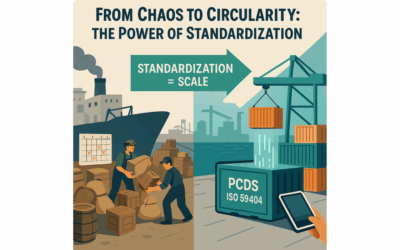Where is the The ‚Shipping Container‘ of Circularity?
Why Data and standardisation, Not Design, Will Scale the Circular Economy
In 2017, while examining how value is created along continuous circular supply chains, I realised a critical bottleneck: circularity was struggling with the same friction that logistics once faced. Each company tracked product circularity differently, each sector relied on its own reporting formats, and every system spoke its own language.
It reminded me of the pre-container shipping era – when goods were reloaded, repackaged, and delayed at every port due to incompatible standards.
The solution was never more ships or better design. It was one standardised box – a universal framework for interoperability across the supply chain.
We don’t need more pilots. We need a protocol.
Circular economy has become one of the most overused phrases of the decade.
We celebrate circular strategies, circular business models, circular materials – and yet the system itself isn’t circular.
Why?
Because the element that made globalisation scalable – standardisation and interoperability – is still missing in the circular economy.
We are building smart factories, digital twins, and sustainability dashboards, but we have not yet implemented the one thing that transformed global trade: a standard framework for circular data.
The box that changed the world
In the 1950s, global trade was chaotic. Goods were handled differently at each port, repackaged for every ship, and delayed for weeks.
Then came the shipping container.
One box. One format. Infinite interoperability.
It sped up logistics and redefined what was possible.
It enabled nations to collaborate, companies to scale, and entire supply chains to synchronise efficiently.
Today, the circular economy faces the same challenge logistics once did: friction at every handover.
Every company tracks product circularity using its own indicators.
Every system relies on a unique file format.
Every certification uses a distinct vocabulary.
Every platform collects separate circular data along the supply chain.
And yet we wonder why circularity measurement fails to scale.
Thanks for reading! Subscribe for free to receive new posts and support my work.
The hidden cost of fragmentation
Circular data is generated everywhere. In sensors, factories, procurement tools, and product lifecycle assessments, yet almost none of it connects.
We collect it, but we rarely compare or standardise it. We discuss circularity, but we do not measure product circularity consistently.
Even the best initiatives (including digital product passports, blockchain pilots, and material databases) often create new silos instead of shared frameworks.
Here, circularity fails because we lack interoperability and standardised circular data.
If every country still used different box sizes, barcodes, and loading standards, global trade would remain local, slow, and expensive. That is exactly what is happening in the circular economy today! Billions are invested, thousands of pilot projects are launched, and no shared data infrastructure is generated. We cannot build circular systems on linear data habits.
The transformation loop
Circularity will only scale when data becomes a shared language – a true “shipping container for circularity.”
This requires a single, open dataset that defines the circular characteristics of a product, including repairability, durability, adaptability, and reuse potential – enabling all actors along the circular supply chain to interpret, verify, and improve it.
Once this foundation exists, a feedback loop emerges:
Circular data → Insights → Design Decisions → Long-term Viable Circular Business Models.
Circularity stops being a compliance exercise and becomes a learning system powered by standardised, comparable data.
From chaos to containers
The shipping container didn’t change what we traded, it changed how we coordinated.
Circular data containers could achieve the same impact: making circularity measurable, comparable, and actionable.
When we can measure product circularity as easily as we move goods, we unlock the next phase of the circular economy, where interoperability and standardisation drive sustainable growth at scale.
The Good News: The Solution is CircularTracker
Standards like ISO 59040 define the shared language of circularity, but organisations still need practical tools to implement them.
That is where CircularTracker comes in.
CircularTracker is a circularity measurement tool designed to help companies and public institutions measure, compare, and showcase the circular characteristics of their products in a standardised, transparent, and efficient way.
Built on the Product Circularity Data Sheet (PCDS), now formally recognised as ISO 59040, it converts complex circular data into clear visual dashboards, making product circularity performance accessible and actionable for teams, clients, and regulators.
Key advantages include:
- Full alignment with ISO 59040, ready to function as a lightweight Digital Product Passport (DPP).
- Quick, 360° insights into product circularity without disclosing sensitive data.
- Visual and compelling reporting tools for clear stakeholder communication.
- Compliance support for EU regulations, including CSRD and ESPR.
- Comparability across product portfolios, enabling benchmarking and strategic decision-making.
CircularTracker is already implemented across construction, manufacturing, and textiles, empowering organisations to demonstrate leadership in the circular economy, respond to transparency requests, and prepare for forthcoming EU requirements.
Try it out for free: https://circulartracker.eu/




0 Kommentare